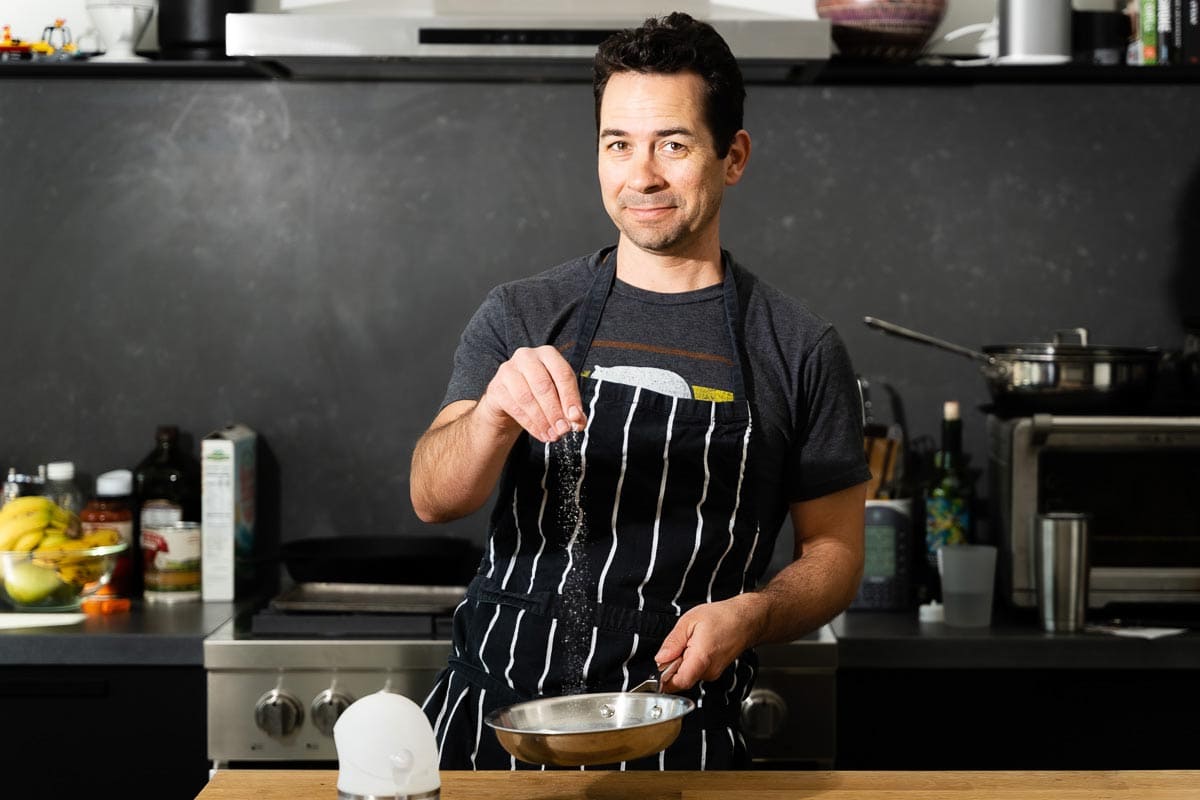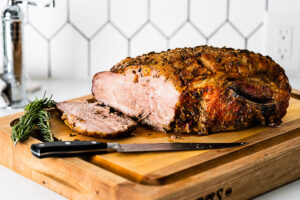Below are some rules that I’m betting will help you become a better cook and gain confidence in the kitchen. If most rules are meant to be broken, you should at least understand the rule in the first place, and when to break it. Think of them as guidelines rather than strict laws, but give them some thought.
Cooking is a lot like driving. There are rules to obey, and there are directions you take to get where you are going with minimum hassle. But between fridge and plate, there is a lot of room for your own judgment and experience. Think of cooking on the stove: You can’t just keep the gas floored the whole way; you have to turn it up and down to adapt to your situation.
Pro chefs are like Formula 1 drivers. But the concepts they use are the same ones that get you around your kitchen every day. If you ever wonder why restaurant dishes sometimes taste so much better than what you make at home, chances are it’s simply because they seasoned it correctly with salt, used more fat than you would have, used higher quality ingredients, employed a few savvy techniques and have the correct equipment.
These are all things you can do at home and provide a formula for better-tasting food.
1. Learn to Season (Salt) Your Food Properly.
Using the right type of salt, the proper amount (by converting the measurements) and salting your food at the right time makes a massive difference in a finished dish. Using the correct amount of salt takes practice and using the same type and brand will make it easier because the results are more consistent.
And you usually have to season more than you think. Salt in layers a little with each step instead of a lot at the end. This will make the dish taste like the ingredients, rather than being salty.
Learn more about salt in the Salt 101 quick guide.
2. Use the Right Fat, and More of It.
More fat? That sounds crazy. But yep, chances are you aren’t using enough fat when you are cooking. And more good fats aren’t necessarily bad for you. Just because you use fat during the cook, doesn’t mean you are actually going to consume all of it. Fat is flavor, but it also helps prevent sticking and assists with browning (the Maillard reaction). Using high-quality butter that actually tastes like butter makes a big difference too. Drizzle a little high-quality olive oil over pasta or a fish dish. You can even make your own beef tallow from brisket trimmings, which helps reduce food waste.
And as for olive oil, it shouldn’t be used for sautéing or cooking with high heat. It has a lower smoke point than neutral oils like grapeseed and canola oil, which can be heated to a much higher temperature before the oil burns and gives off a bad flavor. So, choose the right oil or fat for the job.
3. Buy Higher Quality Ingredients.
From salmon and produce to olive oils and vinegars, higher quality generally means more flavor, usually healthier and often better for the environment. Get to know your farmer, your butcher, and your fisherman, and learn to shop at farmer’s markets. It’s healthier and more satisfying to eat less but better food. Since food is so darn expensive, learn to get to zero waste.
4. Mise en Place, Please.
You have probably heard the term, which translates to “everything in its place.” It’s what restaurant cooks rely on for functioning in an efficient kitchen. But once you make it a habit at home, it can change your mindset in the kitchen.
Create zones in your fridge and in your pantry. When like ingredients and equipment are together, they are easy to find and easy to put away. It’s a little like your closet where all your sweaters go together.
When prepping and cooking, keep what you need within close proximity to your cutting board. Don’t reach an extra 6 inches to put something in a bowl when it can be 2 inches away. This saves a lot of time over the course of prepping. For example, use a garbage bowl (or a Vitamix Foodcycler) right on the counter for disposing of all your scraps so you don’t have to continually open the trash.
Batch like tasks: If you have to peel multiple vegetables, do all of those at the same time. Do all the chopping at the same time. Prep your proteins first that need to be seasoned early. And this work doesn’t have to be just on a per-meal basis. Batching can work for planning out an entire week of meals. Prepare for the week ahead: Peel, chop and even cook certain things ahead of time.
This is how you can get meals on the table faster and have more fun doing it.
Don’t forget the wine and tunes! There’s just something about pouring a glass of wine (or beer) and filling the room with your favorite music when it’s time to get down to business in the kitchen that just makes the whole experience a joy. Make things fun! You will taste the difference in the results. Take a moment (and a sip) to visualize what you are about to do before jumping right in.
5. Cook by Temperature, Not by Time.
It’s easy to rely on the ol’ timer for when your food should be done according to the recipe, and just assume that it is done. However, there are numerous variables that affect cooking time based on your environment. Cooking to a temperature is exact and accurate to your situation. Cooking to temperature is the best way to nail perfect doneness.
Use a high-quality thermometer not only to check doneness but also to check your oven temperature, which likely isn’t exactly what you set it to. I keep an oven thermometer in place to be able to check the actual temperature.
Carryover cooking: Be aware that big roasts and other larger dishes will have carryover cook, meaning the absorbed heat will continue to cook the food and raise the core temperature even after you remove the heat source. So, you will want to remove it from the heat source prior to it reaching the finish temp to keep it from overcooking. The larger the piece of meat or dish, the larger the carryover effect.
Don’t skip the rest for large cuts of meat, since they need to rest in order for the juices to be re-absorbed so they don’t bleed out. Rest time depends on the size of the protein and the temp it was cooked to.
6. Taste as You Go.
You see chefs doing it all the time, and it’s not because they are hungry. There’s nothing more important for getting better than to be constantly taste testing. Flavors develop and progress at every step, and you want to know what each change does by tasting it. That way, you can replicate and keep getting better at mastering flavor development, balance and consistency.
7. Use the Recipe as a Guideline, Not a Strict Rule.
Recipes are great. But strictly following recipes every time gets exhausting. Relax, and stop relying on sticking to a recipe to a T (unless it’s a cake; baking instructions are more precise). Get a little creative by reading a recipe all the way through and then use it as a rough outline to get yourself to a dish that was fun to make with your own creativity. Think about where you might want to make changes and give them a try. It’s still going to be delicious and probably even more rewarding.
8. Master a Single Technique, Then Move to the Next.
There are a lot of techniques and skills to learn in the kitchen, and it can feel overwhelming. Getting really good at one thing makes learning the next even easier, rather than trying to learn too much at one time.
Example: Learn to use your oven. Cook everything in that oven for a few weeks and you will see yourself improve and get comfortable with it. Sear with the broiler. Use the convection setting to evenly brown a roast chicken. Roast the veggies instead of steaming them. Use the low temperature to reverse sear rather than cooking that steak on the grill. Everything is made in that oven.
Once you have leveled up that skill, then move to a skillet, grill during grilling season, give sous vide a try to cook everything and meal prep, etc. The confidence you will gain is empowering and it will make you such a better cook.
9. Keep It Clean.
A clean kitchen is a happy kitchen (and a great kitchen resolution). I like to use the 40/20 rule for cooking and cleaning: For every hour in the kitchen, prep and cook for 40 minutes, then spend 20 minutes cleaning (45/15 or even 50/10 will also do, in a pinch). You will find your kitchen much cleaner by the time dinner is served, and the meal will probably be a lot better too. Forget this rule and it’s easy to end up at the end of the night with stacks of dishes that make you feel like you never want to cook for anyone again.
I also like to go to bed with a tidy kitchen. Ending your night with a clean kitchen takes just a few extra minutes, and makes coming into the kitchen the next morning so pleasant. Clear the counter of anything that doesn’t belong, put away washed dishes, etc. Paired with the 40/20 rule when cooking, keeping things tidy won’t take much time at all!
Then empty the dishwasher first thing in the morning. This simple task just takes a few extra minutes in the morning, but it makes the rest of the day so much more streamlined, as you can just put the dirty stuff in the washer as you go.
Get the grill ready for grilling season (even if it’s past spring.
10. Invest in Quality Cookware, Especially Your Skillets.
Not only will quality cookware actually cook your food better, but it can last a lifetime. Closest to my heart are the skillets. There’s a skillet for every job and many different types. While there is some overlap, having a variety is important. A nonstick skillet might be great for scrambling eggs, but it’s not great for searing a steak.
I still have some of the same All-Clad cookware and cast-iron skillets that I’ve had since high school that I use every day. They function good as new because they started out as quality pieces and have been taken care of.







This is a rule I follow stay in close proximity while cooking we heard the saying a watched pot won’t boil but watch your food while cooking for kitchen safety don’t leave the kitchen unattended.
In an online world filled with ideas and wordy but inane pretexts to recipes, THANK YOU for thinking of some real content and practical guidelines for making us better cooks. Much appreciated!
So glad to hear you enjoyed the tips in here, Kris! Thanks for the feedback.